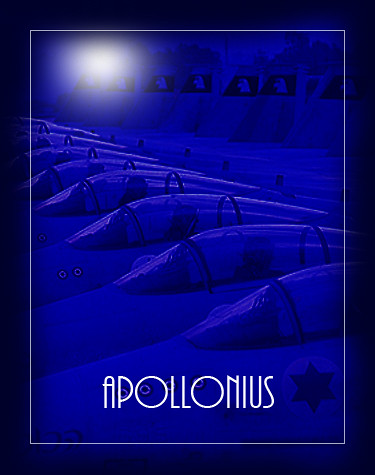
Volume XIII, Issue XII
Apollonius
By Bob Kirchman
Copyright © 2017, The Kirchman Studio, all rights reserved
Chapter 6: The Mad Monk Squadron
Abiyah Ben Gurion seemed most at home in the cockpit of an F17, at least that is how it seemed to Sarah Cohen as she first tried to understand the man who commanded her squadron. He said little. He gave few clues. Most of the men and women in his command knew that he had studied engineering at MIT, but returned home to Israel determined to make as much difference as he could to his tiny country. As a boy, he’d had a fascination with flying and had his pilot’s license as a teenager. He must have had some wild adventures, but he never spoke of any. Outside of command, he rarely spoke unless spoken to. If you met him on the street, his short stature made you miss the fact that he was lean and muscular. He avoided showing that off too. Though there were rumors that he could drink bigger men under the table, he was only actually known to enjoy a polite drink at beer-call with his colleagues and go home early. Serving under him, as a strong pilot in her own right, Cohen began to see inside the man.
Once they were on leave in Jerusalem and as they walked in the old city, a suicide bomber/active shooter situation developed around them. After the initial blast, a sniper was attempting to inflict more casualties on the first-responders. There was a little Arab boy standing dazed in the street and before Sarah could articulate it in a sentence, Ben-Gurion had pushed her into a doorway, rushed out to grab the kid and ducking erratically, managed to return with the frightened child to the safety of the doorway. One of Ben-Gurion’s fellow flyers saw where the shooter was and ended the terror with a well-placed shot from her sidearm. Abiyah was concentrating on comforting the boy and it seemed like he was oblivious to the greater events playing out around him… until he congratulated his colleague: “Nice shot, Rachel.” “He must have some incredible peripheral vision!” Cohen thought to herself. The fact is they both scored exceptionally in that area at about the same level.
His only recreations seemed to be reading and nature photography. That was something he and Sarah shared. Gradually the two pilots found themselves sharing their hobby. Abiyah loved to photograph flowers and often visited the commercial nurseries where thousands grew. His stunning macros actually became quite sought after as he marketed them under a pseudonym. He had just recently become more serious in reading and studying Torah, his mind opened to the possibility of worlds unseen. Sarah was the product of a good Liberal home and initially listened politely as Abiyah shared his personal journey. The fact is the two were drawn to each other and it would be only a matter of time before Sarah thought feelings might be expressed. Abiyah seemed to have one great dream… he wanted to see the desert “blossom like a rose.” Then there came an unprecedented rain and the opportunity for leave. “Sarah,” he said, “I have wanted to see this. I’ve secured a pass for both of us. Would you come with me to see the blooms in the desert?”
Yes, Abiyah!” Sarah spoke before thinking.
They drove to a little hotel by the Sea of Galilee and checked in. From there it was a short drive to the desert where the recent rain had unleashed a vibrant display of wildflowers.
If the truth be known, the two had become quite good friends. They were probably already considered a ‘couple’ by their colleagues but the taciturn Abiyah seemed to take their friendship for granted. “Did he have family?” Sarah wondered. Sarah had learned, however, that there was substance behind the silence. She trusted that as she gave herself to him in her mind.
The two set into photographing desert flowers but Abiyah seemed to have something on his mind. Pilots learn to read cues from one another and Sarah said “Penny for your thoughts?” absently.
Oh, Sarah, I was just thinking…” an exceptionally vivid desert rose seemed to distract him for a moment, “…about you… and, er… us!”
Abiyah Ben-Gurion obviously was pretty lame when it came to pick-up lines. “What about us?” Sarah returned.
I don’t want to live without you.” Abiyah blurted out. “I was just wondering how you felt about me?”
Well, most of our colleagues think we’re already pretty intimate.”
Do they?” Ben-Gurion asked, not so incredulously. “Is it that obvious in my eyes?”
Sarah said nothing.
Even though I am an uncommunicative old goat, you can still see the love that I have for you Sarah?”
I can.”
“…and what do you think of that, dear Sarah? I see your affection for me, but is it love of the same fervor as mine for you?”
I love you, I love you, I love you; Abiyah Ben Gurion.” She replied through tears. “There, does three times make it clear?”
Quite!” he said, as they lost themselves in embrace.
I want you in the worst way,” Ben-Gurion continued after they had walked blissfully through the desert wonderland for some time.
I am yours.” the woman responded, kissing him passionately. “Have me!”
I mean..” the man stammered, “I want you before God! Under a chupah! …and I do want you! Body, Soul and Spirit!" Sarah blushed. In the complex and convoluted world of modern ‘romance,’ such directness caught her off her guard, but in truth, she desired the same and nodded her approval.
The Chupah, and a few friends hastily gathered by the Sea of Galilee witnessed the marriage of Sarah and Abiyah. “We’ll make it public when we can,” Ben Gurion said, “But today we’ve made it forever.”
Someday I want to live in a place that’s called ’Shalom’ and make mad love to you until we fill our house with children.” Abiyah said as they slipped off to consummate their marriage.
Aliyah Ben Gurion would only lay claim to one virtue, that being gratitude. In the time that followed their whirlwind marriage, Sarah would learn that her husband began life as an orphan in London. His early years were wretched ones. His kind adoptive parents gave him a name that would command respect by its mere mention in their home country… and a name that carried with it a great hope and a future!
They indulged his passion for aviation, taught him Hebrew and encouraged his nobler dreams. The boy was filled with wonder at the new world that opened up to him when his parents immigrated to Israel and sent him to university in America. While many young people take their good fortune for granted and often treat their parents and home country with distain, Ben Gurion never got over the wonder.
He was a wild, tough youth of course. But he ultimately channeled that wildness to give something back to everyone who had blessed him… and that is what led him to love Torah. He read the history of his new adopted country. “Was this the work simply of a great people,” he wondered, “or is my land’s miraculous history truly from the hand of the Divine?”
His gratitude found a new focus as he read the Holy Texts. Like most young people he suffered through a series of awkward attempts at romance. When young and beautiful Sarah became part of his life, his gentleness toward her sprang from the most fervent gratitude to the Lord almighty!
(to be continued)

Jules Verne and Walt Disney
Journeys into the Imagination
Reportage sur l'importance de Jules Verne dans le monde créatif de Disney.
Around the World in 80 Days
By Jules Verne, Chapter XIII
In which Passepartout Receives a New Proof that Fortune Favors the Brave
The project was a bold one, full of difficulty, perhaps impracticable. Mr. Fogg was going to risk life, or at least liberty, and therefore the success of his tour. But he did not hesitate, and he found in Sir Francis Cromarty an enthusiastic ally.
As for Passepartout, he was ready for anything that might be proposed. His master’s idea charmed him; he perceived a heart, a soul, under that icy exterior. He began to love Phileas Fogg.
There remained the guide: what course would he adopt? Would he not take part with the Indians? In default of his assistance, it was necessary to be assured of his neutrality.
Sir Francis frankly put the question to him.
Officers,” replied the guide, “I am a Parsee, and this woman is a Parsee. Command me as you will.”
Excellent!” said Mr. Fogg.
However,” resumed the guide, “it is certain, not only that we shall risk our lives, but horrible tortures, if we are taken.”
That is foreseen,” replied Mr. Fogg. “I think we must wait till night before acting.”
I think so,” said the guide.
The worthy Indian then gave some account of the victim, who, he said, was a celebrated beauty of the Parsee race, and the daughter of a wealthy Bombay merchant. She had received a thoroughly English education in that city, and, from her manners and intelligence, would be thought an European. Her name was Aouda. Left an orphan, she was married against her will to the old rajah of Bundelcund; and, knowing the fate that awaited her, she escaped, was retaken, and devoted by the rajah’s relatives, who had an interest in her death, to the sacrifice from which it seemed she could not escape.
The Parsee’s narrative only confirmed Mr. Fogg and his companions in their generous design. It was decided that the guide should direct the elephant towards the pagoda of Pillaji, which he accordingly approached as quickly as possible. They halted, half an hour afterwards, in a copse, some five hundred feet from the pagoda, where they were well concealed; but they could hear the groans and cries of the fakirs distinctly.
They then discussed the means of getting at the victim. The guide was familiar with the pagoda of Pillaji, in which, as he declared, the young woman was imprisoned. Could they enter any of its doors while the whole party of Indians was plunged in a drunken sleep, or was it safer to attempt to make a hole in the walls? This could only be determined at the moment and the place themselves; but it was certain that the abduction must be made that night, and not when, at break of day, the victim was led to her funeral pyre. Then no human intervention could save her.
As soon as night fell, about six o’clock, they decided to make a reconnaissance around the pagoda. The cries of the fakirs were just ceasing; the Indians were in the act of plunging themselves into the drunkenness caused by liquid opium mingled with hemp, and it might be possible to slip between them to the temple itself.
The Parsee, leading the others, noiselessly crept through the wood, and in ten minutes they found themselves on the banks of a small stream, whence, by the light of the rosin torches, they perceived a pyre of wood, on the top of which lay the embalmed body of the rajah, which was to be burned with his wife. The pagoda, whose minarets loomed above the trees in the deepening dusk, stood a hundred steps away.
Come!” whispered the guide.
He slipped more cautiously than ever through the brush, followed by his companions; the silence around was only broken by the low murmuring of the wind among the branches.
Soon the Parsee stopped on the borders of the glade, which was lit up by the torches. The ground was covered by groups of the Indians, motionless in their drunken sleep; it seemed a battlefield strewn with the dead. Men, women, and children lay together.
In the background, among the trees, the pagoda of Pillaji loomed distinctly. Much to the guide’s disappointment, the guards of the rajah, lighted by torches, were watching at the doors and marching to and fro with naked sabres; probably the priests, too, were watching within.
The Parsee, now convinced that it was impossible to force an entrance to the temple, advanced no farther, but led his companions back again. Phileas Fogg and Sir Francis Cromarty also saw that nothing could be attempted in that direction. They stopped, and engaged in a whispered colloquy.
It is only eight now,” said the brigadier, “and these guards may also go to sleep.”
It is not impossible,” returned the Parsee.
They lay down at the foot of a tree, and waited.
The time seemed long; the guide ever and anon left them to take an observation on the edge of the wood, but the guards watched steadily by the glare of the torches, and a dim light crept through the windows of the pagoda.
They waited till midnight; but no change took place among the guards, and it became apparent that their yielding to sleep could not be counted on. The other plan must be carried out; an opening in the walls of the pagoda must be made. It remained to ascertain whether the priests were watching by the side of their victim as assiduously as were the soldiers at the door.
After a last consultation, the guide announced that he was ready for the attempt, and advanced, followed by the others. They took a roundabout way, so as to get at the pagoda on the rear. They reached the walls about half-past twelve, without having met anyone; here there was no guard, nor were there either windows or doors.
The night was dark. The moon, on the wane, scarcely left the horizon, and was covered with heavy clouds; the height of the trees deepened the darkness.
It was not enough to reach the walls; an opening in them must be accomplished, and to attain this purpose the party only had their pocket-knives. Happily the temple walls were built of brick and wood, which could be penetrated with little difficulty; after one brick had been taken out, the rest would yield easily.
They set noiselessly to work, and the Parsee on one side and Passepartout on the other began to loosen the bricks so as to make an aperture two feet wide. They were getting on rapidly, when suddenly a cry was heard in the interior of the temple, followed almost instantly by other cries replying from the outside. Passepartout and the guide stopped. Had they been heard? Was the alarm being given? Common prudence urged them to retire, and they did so, followed by Phileas Fogg and Sir Francis. They again hid themselves in the wood, and waited till the disturbance, whatever it might be, ceased, holding themselves ready to resume their attempt without delay. But, awkwardly enough, the guards now appeared at the rear of the temple, and there installed themselves, in readiness to prevent a surprise.
It would be difficult to describe the disappointment of the party, thus interrupted in their work. They could not now reach the victim; how, then, could they save her? Sir Francis shook his fists, Passepartout was beside himself, and the guide gnashed his teeth with rage. The tranquil Fogg waited, without betraying any emotion.
We have nothing to do but to go away,” whispered Sir Francis.
Nothing but to go away,” echoed the guide.
Stop,” said Fogg. “I am only due at Allahabad tomorrow before noon.”
But what can you hope to do?” asked Sir Francis. “In a few hours it will be daylight, and —”
The chance which now seems lost may present itself at the last moment.”
Sir Francis would have liked to read Phileas Fogg’s eyes. What was this cool Englishman thinking of? Was he planning to make a rush for the young woman at the very moment of the sacrifice, and boldly snatch her from her executioners?
This would be utter folly, and it was hard to admit that Fogg was such a fool. Sir Francis consented, however, to remain to the end of this terrible drama. The guide led them to the rear of the glade, where they were able to observe the sleeping groups.
Meanwhile Passepartout, who had perched himself on the lower branches of a tree, was resolving an idea which had at first struck him like a flash, and which was now firmly lodged in his brain.
He had commenced by saying to himself, “What folly!” and then he repeated, “Why not, after all? It’s a chance perhaps the only one; and with such sots!” Thinking thus, he slipped, with the suppleness of a serpent, to the lowest branches, the ends of which bent almost to the ground.
The hours passed, and the lighter shades now announced the approach of day, though it was not yet light. This was the moment. The slumbering multitude became animated, the tambourines sounded, songs and cries arose; the hour of the sacrifice had come. The doors of the pagoda swung open, and a bright light escaped from its interior, in the midst of which Mr. Fogg and Sir Francis espied the victim. She seemed, having shaken off the stupor of intoxication, to be striving to escape from her executioner. Sir Francis’s heart throbbed; and, convulsively seizing Mr. Fogg’s hand, found in it an open knife. Just at this moment the crowd began to move. The young woman had again fallen into a stupor caused by the fumes of hemp, and passed among the fakirs, who escorted her with their wild, religious cries.
Phileas Fogg and his companions, mingling in the rear ranks of the crowd, followed; and in two minutes they reached the banks of the stream, and stopped fifty paces from the pyre, upon which still lay the rajah’s corpse. In the semi-obscurity they saw the victim, quite senseless, stretched out beside her husband’s body. Then a torch was brought, and the wood, heavily soaked with oil, instantly took fire.
At this moment Sir Francis and the guide seized Phileas Fogg, who, in an instant of mad generosity, was about to rush upon the pyre. But he had quickly pushed them aside, when the whole scene suddenly changed. A cry of terror arose. The whole multitude prostrated themselves, terror-stricken, on the ground.
The old rajah was not dead, then, since he rose of a sudden, like a spectre, took up his wife in his arms, and descended from the pyre in the midst of the clouds of smoke, which only heightened his ghostly appearance.
Fakirs and soldiers and priests, seized with instant terror, lay there, with their faces on the ground, not daring to lift their eyes and behold such a prodigy.
The inanimate victim was borne along by the vigorous arms which supported her, and which she did not seem in the least to burden. Mr. Fogg and Sir Francis stood erect, the Parsee bowed his head, and Passepartout was, no doubt, scarcely less stupefied.
The resuscitated rajah approached Sir Francis and Mr. Fogg, and, in an abrupt tone, said, “Let us be off!”
It was Passepartout himself, who had slipped upon the pyre in the midst of the smoke and, profiting by the still overhanging darkness, had delivered the young woman from death! It was Passepartout who, playing his part with a happy audacity, had passed through the crowd amid the general terror.
A moment after all four of the party had disappeared in the woods, and the elephant was bearing them away at a rapid pace. But the cries and noise, and a ball which whizzed through Phileas Fogg’s hat, apprised them that the trick had been discovered.
The old rajah’s body, indeed, now appeared upon the burning pyre; and the priests, recovered from their terror, perceived that an abduction had taken place. They hastened into the forest, followed by the soldiers, who fired a volley after the fugitives; but the latter rapidly increased the distance between them, and ere long found themselves beyond the reach of the bullets and arrows.
(to be continued)
Trees in the Mist
Photos by Bob Kirchman
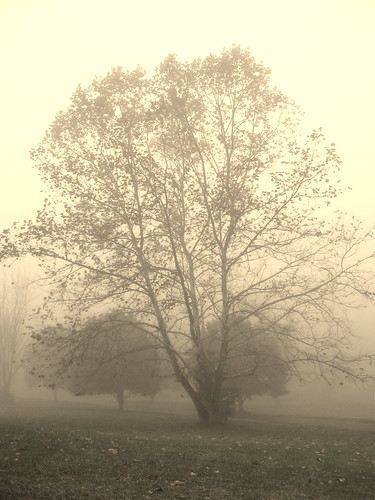
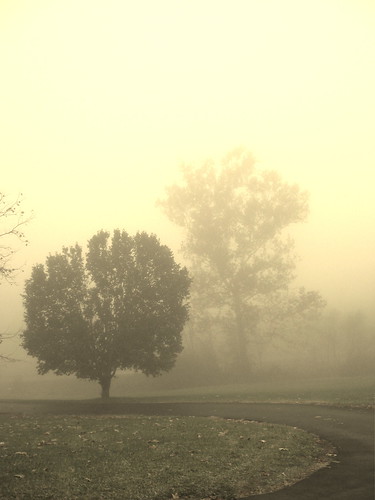
Around the World in 80 Days
By Jules Verne, Chapter XIV
In which Phileas Fogg Descends the Whole Length of the Beautiful Valley of the Ganges Without Ever Thinking of Seeing it
The rash exploit had been accomplished; and for an hour Passepartout laughed gaily at his success. Sir Francis pressed the worthy fellow’s hand, and his master said, “Well done!” which, from him, was high commendation; to which Passepartout replied that all the credit of the affair belonged to Mr. Fogg. As for him, he had only been struck with a “queer” idea; and he laughed to think that for a few moments he, Passepartout, the ex-gymnast, ex-sergeant fireman, had been the spouse of a charming woman, a venerable, embalmed rajah! As for the young Indian woman, she had been unconscious throughout of what was passing, and now, wrapped up in a travelling-blanket, was reposing in one of the howdahs.
The elephant, thanks to the skilful guidance of the Parsee, was advancing rapidly through the still darksome forest, and, an hour after leaving the pagoda, had crossed a vast plain. They made a halt at seven o’clock, the young woman being still in a state of complete prostration. The guide made her drink a little brandy and water, but the drowsiness which stupefied her could not yet be shaken off. Sir Francis, who was familiar with the effects of the intoxication produced by the fumes of hemp, reassured his companions on her account. But he was more disturbed at the prospect of her future fate. He told Phileas Fogg that, should Aouda remain in India, she would inevitably fall again into the hands of her executioners. These fanatics were scattered throughout the county, and would, despite the English police, recover their victim at Madras, Bombay, or Calcutta. She would only be safe by quitting India for ever.
Phileas Fogg replied that he would reflect upon the matter.
The station at Allahabad was reached about ten o’clock, and, the interrupted line of railway being resumed, would enable them to reach Calcutta in less than twenty-four hours. Phileas Fogg would thus be able to arrive in time to take the steamer which left Calcutta the next day, October 25th, at noon, for Hong Kong.
The young woman was placed in one of the waiting-rooms of the station, whilst Passepartout was charged with purchasing for her various articles of toilet, a dress, shawl, and some furs; for which his master gave him unlimited credit. Passepartout started off forthwith, and found himself in the streets of Allahabad, that is, the City of God, one of the most venerated in India, being built at the junction of the two sacred rivers, Ganges and Jumna, the waters of which attract pilgrims from every part of the peninsula. The Ganges, according to the legends of the Ramayana, rises in heaven, whence, owing to Brahma’s agency, it descends to the earth.
Passepartout made it a point, as he made his purchases, to take a good look at the city. It was formerly defended by a noble fort, which has since become a state prison; its commerce has dwindled away, and Passepartout in vain looked about him for such a bazaar as he used to frequent in Regent Street. At last he came upon an elderly, crusty Jew, who sold second-hand articles, and from whom he purchased a dress of Scotch stuff, a large mantle, and a fine otter-skin pelisse, for which he did not hesitate to pay seventy-five pounds. He then returned triumphantly to the station.
The influence to which the priests of Pillaji had subjected Aouda began gradually to yield, and she became more herself, so that her fine eyes resumed all their soft Indian expression.
When the poet-king, Ucaf Uddaul, celebrates the charms of the queen of Ahmehnagara, he speaks thus:
Her shining tresses, divided in two parts, encircle the harmonious contour of her white and delicate cheeks, brilliant in their glow and freshness. Her ebony brows have the form and charm of the bow of Kama, the god of love, and beneath her long silken lashes the purest reflections and a celestial light swim, as in the sacred lakes of Himalaya, in the black pupils of her great clear eyes. Her teeth, fine, equal, and white, glitter between her smiling lips like dewdrops in a passion-flower’s half-enveloped breast. Her delicately formed ears, her vermilion hands, her little feet, curved and tender as the lotus-bud, glitter with the brilliancy of the loveliest pearls of Ceylon, the most dazzling diamonds of Golconda. Her narrow and supple waist, which a hand may clasp around, sets forth the outline of her rounded figure and the beauty of her bosom, where youth in its flower displays the wealth of its treasures; and beneath the silken folds of her tunic she seems to have been modelled in pure silver by the godlike hand of Vicvarcarma, the immortal sculptor.”
It is enough to say, without applying this poetical rhapsody to Aouda, that she was a charming woman, in all the European acceptation of the phrase. She spoke English with great purity, and the guide had not exaggerated in saying that the young Parsee had been transformed by her bringing up.
The train was about to start from Allahabad, and Mr. Fogg proceeded to pay the guide the price agreed upon for his service, and not a farthing more; which astonished Passepartout, who remembered all that his master owed to the guide’s devotion. He had, indeed, risked his life in the adventure at Pillaji, and, if he should be caught afterwards by the Indians, he would with difficulty escape their vengeance. Kiouni, also, must be disposed of. What should be done with the elephant, which had been so dearly purchased? Phileas Fogg had already determined this question.
Parsee,” said he to the guide, “you have been serviceable and devoted. I have paid for your service, but not for your devotion. Would you like to have this elephant? He is yours.”
The guide’s eyes glistened.
Your honour is giving me a fortune!” cried he.
Take him, guide,” returned Mr. Fogg, “and I shall still be your debtor.”
Good!” exclaimed Passepartout. “Take him, friend. Kiouni is a brave and faithful beast.” And, going up to the elephant, he gave him several lumps of sugar, saying, “Here, Kiouni, here, here.”
The elephant grunted out his satisfaction, and, clasping Passepartout around the waist with his trunk, lifted him as high as his head. Passepartout, not in the least alarmed, caressed the animal, which replaced him gently on the ground.
Soon after, Phileas Fogg, Sir Francis Cromarty, and Passepartout, installed in a carriage with Aouda, who had the best seat, were whirling at full speed towards Benares. It was a run of eighty miles, and was accomplished in two hours. During the journey, the young woman fully recovered her senses. What was her astonishment to find herself in this carriage, on the railway, dressed in European habiliments, and with travellers who were quite strangers to her! Her companions first set about fully reviving her with a little liquor, and then Sir Francis narrated to her what had passed, dwelling upon the courage with which Phileas Fogg had not hesitated to risk his life to save her, and recounting the happy sequel of the venture, the result of Passepartout’s rash idea. Mr. Fogg said nothing; while Passepartout, abashed, kept repeating that “it wasn’t worth telling.”
Aouda pathetically thanked her deliverers, rather with tears than words; her fine eyes interpreted her gratitude better than her lips. Then, as her thoughts strayed back to the scene of the sacrifice, and recalled the dangers which still menaced her, she shuddered with terror.
Phileas Fogg understood what was passing in Aouda’s mind, and offered, in order to reassure her, to escort her to Hong Kong, where she might remain safely until the affair was hushed up — an offer which she eagerly and gratefully accepted. She had, it seems, a Parsee relation, who was one of the principal merchants of Hong Kong, which is wholly an English city, though on an island on the Chinese coast.
At half-past twelve the train stopped at Benares. The Brahmin legends assert that this city is built on the site of the ancient Casi, which, like Mahomet’s tomb, was once suspended between heaven and earth; though the Benares of to-day, which the Orientalists call the Athens of India, stands quite unpoetically on the solid earth, Passepartout caught glimpses of its brick houses and clay huts, giving an aspect of desolation to the place, as the train entered it.
Benares was Sir Francis Cromarty’s destination, the troops he was rejoining being encamped some miles northward of the city. He bade adieu to Phileas Fogg, wishing him all success, and expressing the hope that he would come that way again in a less original but more profitable fashion. Mr. Fogg lightly pressed him by the hand. The parting of Aouda, who did not forget what she owed to Sir Francis, betrayed more warmth; and, as for Passepartout, he received a hearty shake of the hand from the gallant general.
The railway, on leaving Benares, passed for a while along the valley of the Ganges. Through the windows of their carriage the travellers had glimpses of the diversified landscape of Behar, with its mountains clothed in verdure, its fields of barley, wheat, and corn, its jungles peopled with green alligators, its neat villages, and its still thickly-leaved forests. Elephants were bathing in the waters of the sacred river, and groups of Indians, despite the advanced season and chilly air, were performing solemnly their pious ablutions. These were fervent Brahmins, the bitterest foes of Buddhism, their deities being Vishnu, the solar god, Shiva, the divine impersonation of natural forces, and Brahma, the supreme ruler of priests and legislators. What would these divinities think of India, anglicised as it is to-day, with steamers whistling and scudding along the Ganges, frightening the gulls which float upon its surface, the turtles swarming along its banks, and the faithful dwelling upon its borders?
The panorama passed before their eyes like a flash, save when the steam concealed it fitfully from the view; the travellers could scarcely discern the fort of Chupenie, twenty miles south-westward from Benares, the ancient stronghold of the rajahs of Behar; or Ghazipur and its famous rose-water factories; or the tomb of Lord Cornwallis, rising on the left bank of the Ganges; the fortified town of Buxar, or Patna, a large manufacturing and trading-place, where is held the principal opium market of India; or Monghir, a more than European town, for it is as English as Manchester or Birmingham, with its iron foundries, edgetool factories, and high chimneys puffing clouds of black smoke heavenward.
Night came on; the train passed on at full speed, in the midst of the roaring of the tigers, bears, and wolves which fled before the locomotive; and the marvels of Bengal, Golconda ruined Gour, Murshedabad, the ancient capital, Burdwan, Hugly, and the French town of Chandernagor, where Passepartout would have been proud to see his country’s flag flying, were hidden from their view in the darkness.
Calcutta was reached at seven in the morning, and the packet left for Hong Kong at noon; so that Phileas Fogg had five hours before him.
According to his journal, he was due at Calcutta on the 25th of October, and that was the exact date of his actual arrival. He was therefore neither behind-hand nor ahead of time. The two days gained between London and Bombay had been lost, as has been seen, in the journey across India. But it is not to be supposed that Phileas Fogg regretted them.
(to be continued)
New Echota, Cherokee Phoenix
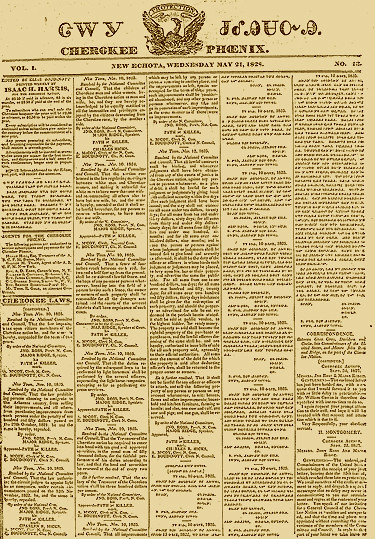
1828 Edition of the Cherokee Phoenix.
Sometime around 1809 a mixed-blood Cherokee known as Sequoyah began developing a written Cherokee language. In 1821 his work was complete. The language had 86 characters and was adopted by the Cherokee Council in 1826. In 1827 Rev. Samuel Worcester helped to establish the Phoenix Printing Office. Using specially forged type, the newspaper had side by side columns of English and Cherokee. It was distributed throughout the Cherokee Nation, the United States and even parts of Europe. In addition to the newspaper, the press also produced a Cherokee Bible, a hymnal and even a novel.
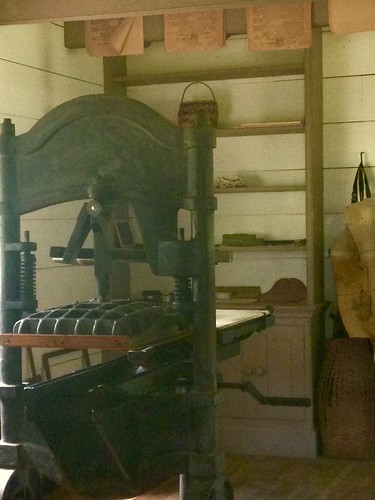
The Phoenix printing press. Photo by Bob kirchman.

This simple printing office managed an international distribution of the Phoenix. Photo by Bob Kirchman.

Sunflowers, Charlottesville, Virginia. Photo by Bob Kirchman
The Texas Sharpshooter Fallacy
The “Texas sharpshooter fallacy” is based on a story about a person who comes to Texas and sees bullet holes in the side of a barn, with a bull’s-eye circle drawn around each hole. The person goes in search of the marksman, who, when found, admits that he simply shot at the barn and drew the circles later. The fallacy has been used in medical research, where clusters of data might be meaningless, just like the shots and circles of the Texas “sharpshooter.”
The “sharpshooter” story has been cited in print since at least 1977 and 1982, although it didn’t specify Texas as the location. Dr. Seymour Grufferman, of Pittsburgh, used the story in “Clustering and aggregation of exposures in Hodgkin’s disease,” Cancer (volume 39, 1977). The name “Texas sharpshooter effect” was used in 1982, “Texas sharpshooter fallacy” was used in 1992 and “Texas sharpshooter problem” in 1995.[1.]
In research methodology, the “Texas Sharpshooter Fallacy” refers to the taking of pieces of information that have no relation to one another, but calling them out for their similarities and then establishing a ‘pattern.’
It is not only a problem in medical research, but in historical research as well, as evidenced in the release yesterday of another book claiming that the author’s research discovers information from thousands of years ago that “reveals that a blueprint dating back almost 3,000 years foretold the calamity, giving the year, month, day and even the hour of September 11, 2001.” [2.] Sixteen years after that tragic day, it is certainly valid to ask how we might prevent another attack, but the ‘clustering’ of information for validation of one’s theories is suspect.
It is rather in the same vein as those alarming advertisements you see on Conservative news sites where the author has you click on a video of slides where he tells you how he predicted every market downturn in the past decade. [3.] It is, unfortunately, a ploy to get you to buy a subscription to his newsletter. There he will tell you how to avoid the NEXT scheduled downturn (just send in your $49.00). But really, such ‘predictions’ are like forecasting the path of a hurricane. You can make all the models you want but you’ll still be surprised. Is it good to understand hurricanes? Yes. Can we predict their exact time and place of arrival? No. [4.]
There is a reason why I like real history. It’s messy. But in that messiness you can learn a lot. I think you can certainly find wisdom as you look to the future, but I think you can find hope as well. History is replete with stories of Divine interaction with flawed ordinary humans. So, my advice is to skip the sensational and instead find a good biography of someone like William Wilberforce or John Wesley. Read the story of the Moravians and their work around the world. Inform yourself and inspire yourself.
Prophecy is not about
The future; it isn’t fortune telling,
It’s more the ache of déjà-vu
Expanded as an open window
That lets you see the obvious
In the free fall, the hydroplane
Of time or mind.”
– Wilmer Mills, ‘For the Unemployed Man at Forty,’ Selected Poems

World Trade Center Memorial Concept by Xaver Wilhelmy. This unique design features a 3000 note pipe organ, giving a voice to everyone who perished that day. Painting by Bob Kirchman.
Painting the Paradise That Used to Be
New Collection Showcases the Poetry of Wilmer Mills
By Tina LoTufo
[click to read]
Poet Wilmer Mills died of liver cancer in 2011 at the age of forty-one, only two months after his diagnosis. He left behind grieving friends and family members, along with scores of beautifully crafted poems. His wife, Kathryn Oliver Mills, served as editor of his new collection, Selected Poems. In an afterword, she lists the many and varied talents of her accomplished husband: farmer, carpenter, singer/songwriter, craftsman, baker, teacher, painter, and most passionately, poet. “Wil was a renaissance man not only for his diverse creative talents,” she writes, “but also … for how his life gave shape to his art, and his art gave shape to his life.” This is a poet who writes from specific, hands-on experience but who also sees beyond the ordinary to touch what is timeless in each act. (read more)

View from Old Rag Mountain. Photo by Bob Kirchman
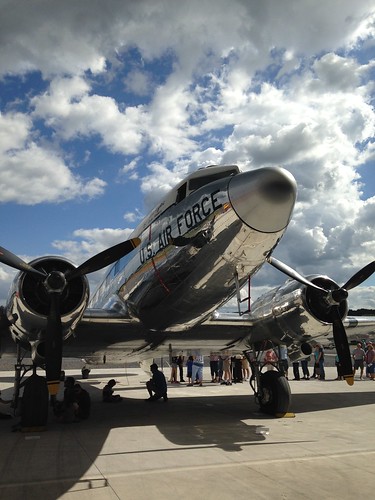
A C-47 at Dynamic Aviation in Bridgewater, Virginia's 50 Year Celebration. Photo by Bob Kirchman.
Fifty Years of Dynamic Aviation
On September 16, 2017, Dynamic Aviation celebrated fifty years of incorporation. When Karl Stoltzfus, Sr. and his twin brother, Ken, moved to the Shenandoah Valley and started K and K Aircraft, they were continuing the Stoltzfus aviation legacy that started in Coatesville, PA with their father’s business, Chris Stoltzfus and Associates. Chris began as a crop duster and the family's love of aviation would lead them places!
Karl and Ken started K and K Aircraft to fund their college education. They bought and sold government surplus parts to build systems trainers for aviation mechanic training schools, and smelted scrap aluminum for resale to aluminum wholesale companies. Each of those experiences were precursors to the purchase of VBW airport in 1974 and the future aircraft leasing and modification business of Dynamic Aviation.
Since that time, there have been many changes as Dynamic Aviation has grown. But one thing has not changed – their commitment to serving others with unwavering excellence. As they go through this year and celebrate their fiftieth anniversary, They invite you to celebrate their amazing history . They heartily thank coworkers and customers who have and will continue to shape Dynamic Aviation’s ongoing story.
Dynamic Aviation is a leading provider of innovative special-mission aviation solutions designed to meet the unique requirements of government and commercial organizations worldwide. Headquartered on its privately-owned, public-use airport in Bridgewater, Va., the company delivers customized aerial assets and services to support a wide range of customers including national defense, military intelligence, federal agencies, state and local governments, non-profit research organizations and private companies.
Dynamic Aviation has the flexibility and resources to deliver world-class aviation solutions that combine mission-modified aircraft, experienced flight crews and comprehensive maintenance services. The company employs approximately 600 aviation professionals, owns more than 140 aircraft and operates from 18 locations across three continents.
Dynamic Aviation offers Aerial Services in the areas of:
Intelligence, Surveillance and Reconnaissance Services
The United States Department of Defense (DoD) is undertaking a major alteration in its capabilities, from a force designed to fight the Soviet Union to one tailored to 21st century adversaries including terrorism. This shift has been prompted by the perception of a changing threat and improved technology, especially information technology. As the military services attempt to increase the agility and versatility of their weapon systems, they also see a need to increase the capabilities of military intelligence, surveillance and reconnaissance (ISR) to support the new weapon systems and operating methods against these new threats. Increasingly, contractor owned and operated aerial platforms have been deployed throughout the world to facilitate this endeavor.
Airborne Data Acquisition Services
Dynamic Aviation specializes in providing aircraft and aviation infrastructure to agencies and organizations with exacting data needs, but lacking aviation expertise. We do not own aerial cameras or remote sensors. Our customers do. We offer versatile, superior aerial platforms into which existing and emerging remote sensing technologies can be integrated to acquire data of all types. By allowing our customers to allocate their capital to technology--not aircraft--Dynamic Aviation makes it possible to operate more efficiently.
Fire Management Services
For many years agencies responsible for fighting wild land fires have recognized the value of lead planes. Often environmental conditions over a fire such as smoke and terrain make target identification difficult. Since 1998, Dynamic Aviation’s fleet of twin engine, turbine-powered King Air lead planes has provided a solution to these problems by offering both better target identification and more standardized flight patterns.
Aerial Application
Dynamic Aviation is a leading provider of aerial application services to federal, state and local governments throughout the United States. The company uses its fleet of specially-equipped, twin-engine, turbine-powered Beechcraft King Airs for aerial adulticiding as a component of integrated mosquito management programs; ORV programs; mating disruption requiring pheromone flake distribution; and application of dispersant in response to an oil spill. Dynamic Aviation has been involved in Rabies vaccinations for over 10 years and has worked in 12 different states from Maine to Texas. They drop specially baited vaccine to attract affected species such as raccoons.
Sterile Insect Technique
An effective alternative to chemical insecticide applications, Sterile Insect Technique (SIT) is a special activity pursued by Dynamic Aviation. With SIT operational experience exceeding 250,000 flight hours, Dynamic Aviation is recognized as the international leader in the release of sterile insects.
Charter and Medevac
Dynamic Aviation offers a diverse fleet of specially-modified aircraft. We provide the ideal platform to meet any unique need with our selection of versatile Beechcraft King Airs, Bombardier Dash-8s, and Cessna and Gulfstream jets to guarantee options and flexibility for any passenger or patient transport requirements. Our aircraft are ideally suited to accommodate short commutes or long-range transcontinental flights and numerous cabin configurations. (BSB One, the fictional plane of Rupert Zimmerman in PONTIFUS is based on the model actually in practice here). [5.]
The Man Who Rediscovered God
The Church is confused about doctrine and morality, Islam threatens to overwhelm Europe, and new technology and scientific discoveries are reshaping economies,” says John Stonestreet.
Sound familiar?
That was the world of 1517, when Martin Luther posted his 95 Theses and ignited a revolution.
The same descriptions could be said of the world today – which is why you should read Eric Metaxas’s new book, Martin Luther: The Man Who Rediscovered God and Changed the World.
